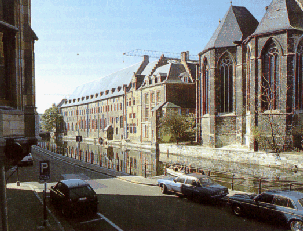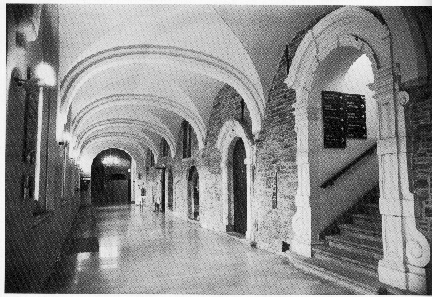Het PandHet Pand lies within walking distance from the most important places of historic and cultural interest in Ghent (see the maps of Ghent section for detailed maps)
Onderbergen 1
9000 Gent

The first ISIPTA '99 symposium
will be held in the conference room Rector Vermeylen (second floor)
of Het Pand, which is located in the historic centre of Ghent, at
the following address:
Het PandHet Pand lies within walking distance from the most important places of historic and cultural interest in Ghent (see the maps of Ghent section for detailed maps) |
 |
 |
Het Pand is a former
Dominican monastery, part of which dates back to the 13th century.
Its oldest wing lies alongside the river Leie, next to the 15th century Sint-Michielskerk (Saint Michael's Church). The building is now owned
by the Universiteit Gent (University
of Ghent), whose history is linked with the former monastery: between 1580
and 1584, a Calvinist Academy existed between its walls, and this historic
fact led the city of Ghent to ask King William I to found a university
in 1817.
|
| Het Pand serves as
the university's cultural centre, and houses its Public Relations and International
Affairs departments, as well as a restaurant, bar, foyer, tea-room and
a number of permanent exhibitions.
|
 |
You arrive in Zaventem (Brussels airport). You can then easily reach Ghent (Gent) by train. In the airport building, go down to the lowest floor (railway station). Take the direct train to Ghent (railway station Gent St-Pieters). There should be at least one train going to Ghent every hour. Alternatively, first take a shuttle train to Brussels (railway station Brussel Zuid/Bruxelles-Midi), and in the railway station Brussel Zuid/Bruxelles-Midi take the train to Ghent.By train/tram (and on foot)
Most international trains (including Thalys and Eurostar) arrive in Brussel Zuid/Bruxelles-Midi. There you can take the train to Gent St-Pieters. This train goes in the direction Brugge-Oostende, but Gent (Ghent) will always be mentioned as an intermediate destination. There is a train from Brussels to Ghent every 30 minutes till +/- 23.00h. The trip Brussels - Ghent takes less then 40 minutes.By busThere is also a direct train connection from Lille (France, station Lille Flandres) to Ghent.
Be careful: always get off in Gent ST-PIETERS and NOT in Gent DAMPOORT!
You arrive in the railway station Gent St-Pieters. On each platform, there is an exit (marked by an ideogram) towards the tram station, which lies next to the railway station. There are numerous stops for buses and trams to the centre of Ghent. To go to the conference centre Het Pand, take trams 1,10, 11, 12 or 13 in the direction Korenmarkt. Get off on the Korenmarkt (you'll see the three towers of Ghent). Cross the bridge over the river Leie, called St-Michielsbrug (St Michael's bridge) in the direction of the St-Michielskerk (St Michael's Church). Turn left to walk around the St-Michielskerk, onto a small square called St-Michielsplein, and into a street called Onderbergen. The conference centre Het Pand lies on your left.
Eurolines offer a direct bus connection to Gent St-Pieters from nearly every big town in every European country. But if they don't, they most probably drive to Brussels (Brussel Noord/Bruxelles-Nord train station). Should they drop you off there, take the train to Gent St-Pieters.By ferry
Some ferry lines go from the United Kingdom to Oostende (Ostend) or Zeebrugge. In Oostende you can take the train to Gent St-Pieters at the ferry terminal. In Zeebrugge you take the train to Brugge (Bruges) and there change trains to Gent St-Pieters.By car
You will probably come in on highways E17 or E40, which intersect near the city (see a map).Highway E17:
via Antwerpen (Antwerp): from The Netherlands, Germany
via Kortrijk: from France
Follow the direction "Gent", and then take direction "Gent Centrum" (B401)Highway E40:
via Oostende (Ostend): from The Netherlands, France
via Brussel (Brussels): from France, Germany
Follow the direction "Gent Antwerpen" (E17), then follow the direction "Gent", and finally follow direction "Gent Centrum" (B401)In both cases the elevated highway (B401) will take you directly to the centre of Ghent. When the highway comes down to ground level, it changes into a street, lined with trees. Driving into Ghent, you will see in front of you the entrance of a large underground parking P3 (Zuid). One suggestion is to park your car here, and to take a tram to the Korenmarkt (see above for what to do once you reach the Korenmarkt). If you are the more adventurous and patient type, you may consider driving your car through the centre of Ghent, to park in the St-Michiels parking (P7), which is located next to the conference centre. To do this, leave the parking Zuid on your left, and follow the signs to the parking P7 (St-Michiels). See the maps of Ghent for more detaled information.
Ghent
is a place rich in history, architecture, culture and gastronomy. It is
also very close (less than 60 km) to other interesting historical Flemish
cities, such as Bruges, Antwerp and Brussels. We have collected a number
of links to
(tourist) information about Ghent, Flanders and Belgium below. What
you'll find here, is Ghent in a few pictures: